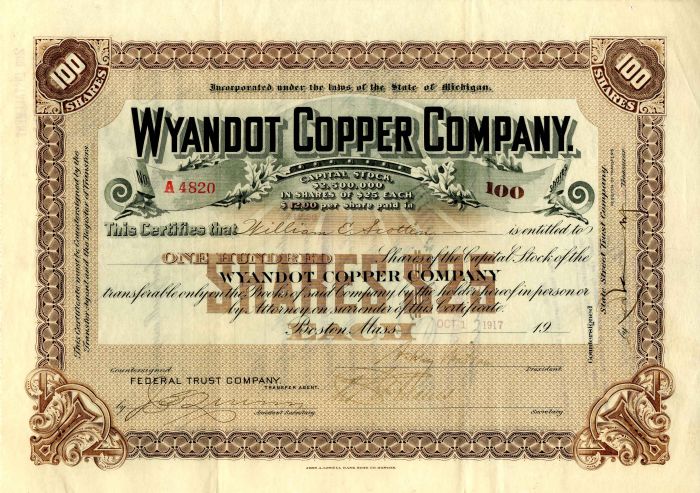Wyandot Copper Co. - Mining Stock Certificate
Inv# GS6045 Stock
Michigan
Wyandot mine - Twin Lakes, Houghton County.
The Wyandot people or Wendat, also called the Huron, are Iroquoian Indigenous peoples of North America who emerged as a confederacy of tribes around the north shore of Lake Ontario, with their original homeland extending to Georgian Bay and Lake Simcoe in Ontario, Canada and occupying some territory around the western part of the lake.
After their defeat during prolonged warfare with the Iroquois in 1649, the surviving members of the confederacy dispersed, some took residence at Quebec with the Jesuits and others were adopted by neighboring nations, such as the Tionontate or Tobacco to become the Wyandot. Later they occupied territory extending into what is now the United States, especially Michigan and northern Ohio.
They were related to other Iroquoian peoples in the region, such as their powerful competitors, the Five Nations of the Iroquois who occupied territory mostly on the south side of Lake Ontario but had hunting grounds along the St. Lawrence River.
In Canada, the Wyandot are known as Huron-Wendat Nation. They have two First Nations reserves within Wendake, Quebec.
Wyandot peoples also lived to the west and south in western Ontario and what became the United States, particularly around Michigan. Those in the US were removed to Indian Territory in the early 19th century, areas of Kansas and Oklahoma. Today, numerous Wyandot in the US are enrolled members of the federally recognized Wyandotte Nation, which is headquartered in Wyandotte, Oklahoma. There are also self-identified Wyandotte groups in Kansas and Michigan.
By the 15th century, the pre-contact Wyandot occupied the large area from the north shores of most of the present-day Lake Ontario, northward up to the southeastern shores of Georgian Bay. From this homeland, they encountered the French explorer Samuel de Champlain in 1615. They historically spoke the Wyandot language, a Northern Iroquoian language. They were believed to number more than 30,000 at the time of European contact in the 1610s to 1620s.
After 1634 their numbers were drastically reduced by epidemics of new infectious diseases carried by Europeans, among whom these were endemic. The weakened Wyandotte were dispersed by the war in 1649 waged by the Iroquois Confederacy of Five Nations, or Haudenosaunee, then based largely south of the Great Lakes in New York and Pennsylvania. Archaeological evidence of this displacement has been uncovered at the Rock Island II Site in Wisconsin.
In the late 17th century, the Huron (Wyandot) Confederacy merged with the Iroquoian-speaking Tionontati nation (known as the Petun in French, also known as the Tobacco people for their chief commodity crop). They may originally have been a splinter colony of the Huron, to their west to form the historical Wyandot.
The Huron Range spanned the region from downriver of the source of the St. Lawrence River, along with three-quarters of the northern shore of Lake Ontario, to the territory of the related Neutral people, extending north from both ends to wrap around Georgian Bay. This became their territorial center after their 1649 defeat and dispossession.
A stock certificate is issued by businesses, usually companies. A stock is part of the permanent finance of a business. Normally, they are never repaid, and the investor can recover his/her money only by selling to another investor. Most stocks, or also called shares, earn dividends, at the business's discretion, depending on how well it has traded. A stockholder or shareholder is a part-owner of the business that issued the stock certificates.









Ebay ID: labarre_galleries